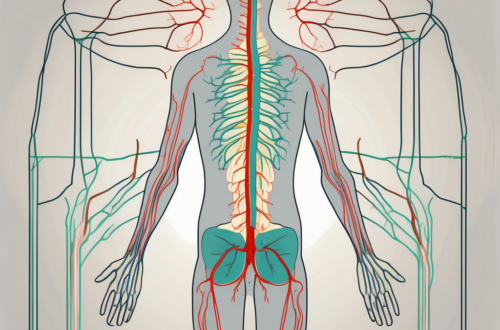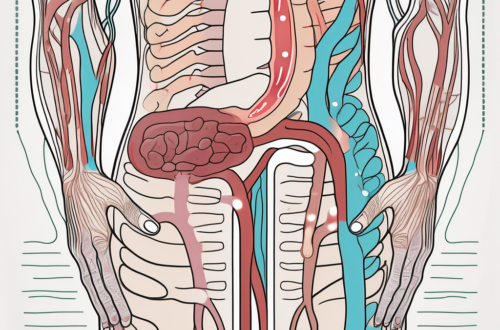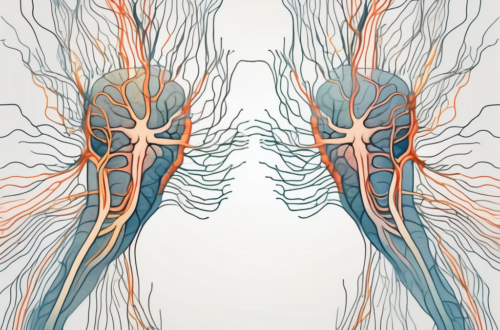The parasympathetic nerve supply of the stomach plays a crucial role in regulating its functions and ensuring proper digestion. To fully comprehend the importance of this system, it is essential to first grasp the basics of the parasympathetic nervous system.
The Basics of the Parasympathetic Nervous System
The parasympathetic nervous system is one of the three divisions of the autonomic nervous system. Its main function is to regulate the body’s rest and digest response, counterbalancing the sympathetic nervous system’s fight or flight response. The parasympathetic nervous system controls various organs and glands, including the stomach.
The parasympathetic nervous system plays a crucial role in maintaining the body’s overall balance and well-being. It works in harmony with the sympathetic nervous system to ensure that the body functions optimally in different situations. While the sympathetic nervous system prepares the body for action and response, the parasympathetic nervous system helps restore calmness and relaxation.
When the parasympathetic nervous system is activated, it triggers a cascade of physiological responses that promote rest and digestion. This activation occurs in situations where the body is at rest, such as after a meal or during periods of relaxation and sleep.
Role and Function of the Parasympathetic Nervous System
The primary role of the parasympathetic nervous system is to conserve energy and maintain homeostasis in the body. It promotes rest, relaxation, and optimal functioning of the digestive system. By stimulating digestion and absorption, it facilitates the breakdown of food and absorption of nutrients.
When the parasympathetic nervous system is active, it signals the release of digestive enzymes and increases blood flow to the digestive organs. This enhanced blood flow ensures that the stomach and intestines receive an adequate supply of oxygen and nutrients, promoting efficient digestion.
Additionally, the parasympathetic nervous system enhances blood flow to the gastrointestinal tract, promoting optimal digestion. It also helps regulate bowel movements by promoting peristalsis, the rhythmic contractions that move food through the intestines.
Furthermore, the parasympathetic nervous system influences other bodily functions, such as lowering heart rate and blood pressure, constricting the pupils, and promoting salivation.
Key Components of the Parasympathetic Nervous System
The parasympathetic nervous system consists of two main components: craniosacral outflow and the vagus nerve. The craniosacral outflow refers to the regions of the brainstem and the sacral region of the spinal cord where the parasympathetic nerves originate.
The vagus nerve, also known as the tenth cranial nerve, is the longest and most critical component of the parasympathetic nervous system. It extends from the brainstem to various organs, including the stomach, where it exerts its control and influence on digestion.
The vagus nerve acts as a communication highway, transmitting signals between the brain and the organs it innervates. It carries information related to digestion, heart rate, breathing, and other vital functions. This nerve plays a vital role in maintaining the balance and coordination of the parasympathetic nervous system.
In addition to the vagus nerve, other cranial nerves, such as the oculomotor nerve, facial nerve, and glossopharyngeal nerve, also contribute to the parasympathetic control of specific organs and functions.
Overall, the parasympathetic nervous system is an essential component of the autonomic nervous system, ensuring that the body can rest, digest, and maintain homeostasis. Its intricate network of nerves and regulatory mechanisms work together to support optimal functioning of various organs, including the stomach.
The Parasympathetic Innervation of the Stomach
Now that we have a basic understanding of the parasympathetic nervous system, let’s explore its innervation of the stomach and its vital functions.
Anatomy of the Stomach’s Parasympathetic Nerve Supply
The stomach’s parasympathetic nerve supply primarily originates from the vagus nerve. The vagus nerve, also known as the tenth cranial nerve, is the longest and most complex of the cranial nerves. It sends branches to various organs in the body, including the stomach, forming the gastric plexuses. These intricate networks of nerves extend throughout the stomach wall, allowing for precise control and coordination of its functions.
The parasympathetic nerve fibers within the gastric plexuses release the neurotransmitter acetylcholine, which binds to specific receptors in the stomach, initiating various physiological responses. Acetylcholine is a key player in the parasympathetic nervous system, responsible for transmitting signals that promote rest, relaxation, and digestion.
Function of the Stomach’s Parasympathetic Nerves
The parasympathetic nerves in the stomach play a crucial role in stimulating gastric motility and promoting optimal digestion. When activated, they increase the secretion of gastric juices and enzymes, which facilitate the breakdown of food.
Furthermore, the parasympathetic nerve fibers in the stomach stimulate the muscular contractions necessary for gastric motility. These contractions, known as peristalsis, help mix the ingested food with the digestive juices, forming a semi-fluid mass known as chyme. The chyme is then gradually propelled into the small intestine for further digestion and absorption.
Additionally, the parasympathetic innervation of the stomach is involved in regulating the release of hormones that aid in digestion. One such hormone is gastrin, which is released by specialized cells in the stomach lining called G cells. Gastrin stimulates the secretion of gastric acid, essential for breaking down proteins and activating digestive enzymes.
Moreover, the parasympathetic nervous system’s influence on the stomach extends beyond digestion. It also plays a role in modulating blood flow to the stomach, ensuring an adequate supply of oxygen and nutrients to support its metabolic needs.
Furthermore, studies have shown that the parasympathetic innervation of the stomach is interconnected with the brain’s emotional centers. This connection explains why stress and anxiety can disrupt digestion, as the activation of the sympathetic nervous system, which opposes the parasympathetic system, can inhibit the stomach’s normal functions.
In summary, the parasympathetic innervation of the stomach is a complex and vital system that regulates various aspects of digestion. From stimulating gastric motility and secretion to modulating blood flow and interacting with emotional centers in the brain, these nerves ensure the efficient breakdown and absorption of nutrients, contributing to overall health and well-being.
The Impact of the Parasympathetic Nervous System on Digestion
The parasympathetic nervous system plays a crucial role in regulating and controlling various aspects of digestion, ensuring its efficient and coordinated functioning. It works in harmony with the sympathetic nervous system to maintain a balance in the body’s physiological processes.
Parasympathetic Control of Gastric Motility
Within the stomach, the parasympathetic nerves exert their influence by stimulating the contraction of smooth muscle fibers in its walls. These contractions, known as peristalsis, play a vital role in propelling food and chyme through the stomach, optimizing digestion and absorption.
Furthermore, the parasympathetic stimulation enhances the release of the hormone gastrin. Gastrin, in turn, acts as a powerful stimulant for gastric motility. It promotes the secretion of gastric acid and other digestive enzymes, crucial for breaking down proteins and aiding in the digestion process.
As the parasympathetic nervous system exerts its control over gastric motility, it ensures the smooth and coordinated movement of food through the stomach, allowing for efficient digestion and absorption of nutrients.
Parasympathetic Influence on Gastric Secretions
In addition to its role in gastric motility, the parasympathetic nervous system also plays a significant role in stimulating the secretion of gastric juices and enzymes necessary for digestion.
One of the key secretions influenced by the parasympathetic stimulation is pepsinogen. Pepsinogen is an inactive enzyme that is converted into its active form, pepsin, under the influence of the parasympathetic nervous system. Pepsin plays a crucial role in breaking down proteins into smaller peptides, facilitating their absorption and utilization by the body.
Moreover, the parasympathetic stimulation promotes the release of hydrochloric acid (HCl) in the stomach. HCl creates an acidic environment essential for the activation of digestive enzymes and the breakdown of various food components. It also helps in killing harmful bacteria and other pathogens that may be present in the ingested food.
By influencing gastric secretions, the parasympathetic nervous system ensures that the stomach has the necessary tools to break down food effectively, extract nutrients, and facilitate their absorption into the bloodstream.
Overall, the parasympathetic nervous system’s impact on digestion is extensive and vital for maintaining optimal digestive function. Its control over gastric motility and secretions ensures that the digestive process occurs smoothly, allowing for the efficient breakdown and absorption of nutrients from the ingested food.
Disorders Related to Parasympathetic Nerve Supply in the Stomach
While the parasympathetic nerve supply of the stomach is crucial for proper digestion, disorders affecting this system can lead to various gastrointestinal symptoms and complications.
The parasympathetic nervous system plays a vital role in regulating the functions of the stomach, including the secretion of digestive enzymes, the movement of food through the digestive tract, and the relaxation of the stomach muscles to accommodate food intake. When this system is disrupted, it can result in a range of disorders that affect the overall digestive process.
Common Symptoms and Diagnosis
Disorders related to the parasympathetic nerve supply of the stomach can manifest in symptoms such as gastrointestinal motility disorders, gastric reflux, and dyspepsia. These conditions may result in symptoms like abdominal pain, bloating, nausea, and altered bowel movements.
Gastrointestinal motility disorders, for example, can cause the stomach to contract too slowly or too quickly, leading to issues with food movement and digestion. Gastric reflux, on the other hand, occurs when the lower esophageal sphincter fails to close properly, allowing stomach acid to flow back into the esophagus, causing heartburn and discomfort. Dyspepsia, commonly known as indigestion, is characterized by persistent or recurrent pain or discomfort in the upper abdomen, often accompanied by bloating, belching, and a feeling of fullness.
If you are experiencing any persistent or concerning symptoms related to digestion, it is essential to consult with a healthcare professional for an accurate diagnosis. They can perform a thorough evaluation, including medical history, physical examination, and additional tests if required, to determine the underlying cause.
During the diagnostic process, your healthcare provider may ask about your symptoms, their duration and severity, as well as any factors that worsen or alleviate them. They may also inquire about your medical history, including any previous gastrointestinal conditions or surgeries. Additionally, they may perform a physical examination to assess your abdomen for tenderness, bloating, or other signs of inflammation.
To further investigate the functioning of the parasympathetic nerve supply in the stomach, your healthcare provider may order additional tests such as gastric emptying studies, esophageal pH monitoring, or endoscopy. These tests can provide valuable insights into the specific nature of the disorder and guide the development of an appropriate treatment plan.
Treatment and Management Options
The treatment and management of disorders related to the parasympathetic nerve supply of the stomach vary depending on the specific condition and underlying cause. It is important to consult with a healthcare professional to develop an individualized treatment plan.
Treatment options may include lifestyle modifications, dietary changes, medications to manage symptoms, and targeted therapies aimed at addressing the underlying cause. Lifestyle modifications may involve adopting a regular eating schedule, avoiding trigger foods that worsen symptoms, and practicing stress-reducing techniques such as meditation or yoga.
Dietary changes can also play a significant role in managing these disorders. Your healthcare provider may recommend a diet that is low in fat, high in fiber, and free from irritants such as caffeine, alcohol, and spicy foods. They may also suggest eating smaller, more frequent meals to ease the workload on the stomach.
In some cases, medications may be prescribed to help alleviate symptoms and improve gastrointestinal function. These may include antacids to neutralize stomach acid, prokinetic agents to enhance gastric motility, or proton pump inhibitors to reduce acid production. Additionally, if an underlying infection or inflammation is identified, antibiotics or anti-inflammatory medications may be prescribed.
In more severe cases or when conservative measures fail to provide relief, targeted therapies may be considered. These may include procedures such as gastric electrical stimulation, which involves implanting a device to regulate the electrical activity of the stomach, or surgical interventions to correct structural abnormalities or remove obstructions.
The goal of treatment and management is to optimize gastrointestinal function, alleviate symptoms, and improve overall quality of life. It is important to work closely with your healthcare provider to monitor your progress and make any necessary adjustments to your treatment plan.
Future Research and Developments
Advances in understanding the parasympathetic nervous system’s intricacies and its influence on gastrointestinal health hold immense potential for future developments in treatment and management strategies.
Advances in Understanding the Parasympathetic Nervous System
Ongoing research seeks to deepen our understanding of the parasympathetic nervous system’s mechanisms, including its role in regulating gastrointestinal health. Scientists are exploring the interactions between the parasympathetic nervous system and other factors, such as the gut microbiota and immune system, in the context of digestive disorders.
One area of focus is the study of the vagus nerve, a major component of the parasympathetic nervous system. Researchers are investigating the intricate pathways and signaling molecules involved in the communication between the vagus nerve and the gastrointestinal tract. By unraveling these complex interactions, scientists hope to identify potential targets for therapeutic interventions.
Furthermore, recent studies have shed light on the role of the enteric nervous system, often referred to as the “second brain,” in gastrointestinal health. This intricate network of neurons lining the digestive tract works in tandem with the parasympathetic nervous system to regulate various digestive processes. Understanding the interplay between these two systems may provide valuable insights into the development of new treatment strategies for gastrointestinal disorders.
Potential Implications for Gastrointestinal Health
As we gain further insights into the parasympathetic nerve supply of the stomach, potential implications for gastrointestinal health are being uncovered. Targeted therapies directed at modulating the parasympathetic system may offer new approaches to managing gastrointestinal disorders and improving overall digestive health.
For instance, researchers are exploring the potential of bioelectronic medicine, a cutting-edge field that involves using electrical stimulation to modulate neural circuits. By precisely targeting the parasympathetic nervous system, scientists hope to restore balance and alleviate symptoms associated with digestive disorders, such as irritable bowel syndrome and gastroparesis.
Moreover, advancements in our understanding of the parasympathetic nervous system may lead to the development of personalized medicine approaches. By identifying specific genetic and environmental factors that influence parasympathetic function, healthcare providers could tailor treatment plans to individual patients, maximizing therapeutic efficacy and minimizing side effects.
Additionally, the emerging field of neurogastroenterology aims to integrate neuroscience and gastroenterology to better understand the complex relationship between the brain and the gut. By studying the impact of emotions, stress, and psychological factors on parasympathetic function, researchers hope to uncover novel therapeutic targets for gastrointestinal disorders.
In conclusion, understanding the parasympathetic nerve supply of the stomach is crucial for comprehending its role in digestion and overall gastrointestinal health. The parasympathetic nervous system plays a vital role in regulating various aspects of digestion, such as gastric motility and secretion, ultimately promoting optimal functioning of the digestive system. As research continues to advance our understanding of this complex system, it holds promise for the development of innovative treatments and management strategies for gastrointestinal disorders.





